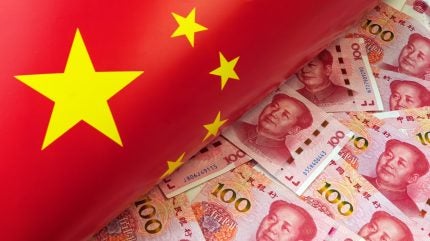
China’s overseas lending trends are shifting, with the country now directing more than three-quarters of its overseas lending towards upper-middle and high-income economies such as the US and EU, and prioritising sensitive sectors.
According to a report from AidData, a research laboratory at William & Mary University in the US, China’s global lending and grant activities reached $2.2tn across 200 nations between 2000 and 2023.

Discover B2B Marketing That Performs
Combine business intelligence and editorial excellence to reach engaged professionals across 36 leading media platforms.
The US is the largest individual recipient of Chinese official credit, having received more than $200bn through nearly 2,500 projects and initiatives across almost every state. These investments encompass a wide range of sectors including pipelines, logistics infrastructure, data centres and corporate credit facilities.
The UK obtained $60bn (£45.82bn), while the EU obtained $161bn (€139.58bn) in Chinese credit from 2000 to 2023.
Historically, China’s lending was associated with developing nations through the Belt and Road Initiative (BRI).
AidData’s analysis shows a transition towards advanced economies and strategic industries.

US Tariffs are shifting - will you react or anticipate?
Don’t let policy changes catch you off guard. Stay proactive with real-time data and expert analysis.
By GlobalDataThe share of China’s lending to low and lower-middle-income nations has declined, dropping to just 12% in 2023 from 88% in 2000.
Beijing has also reduced its infrastructure lending to the Global South under the BRI.
China’s lending to middle and high-income nations rose to 76% in 2023 from 24% in 2000.
AidData senior research analyst and report co-author Sheng Zhang said: “China has never fallen below the $100bn a year threshold since the Belt and Road Initiative, its flagship global infrastructure programme, was first announced, which means that it has remained the world’s largest official creditor for at least a decade.”
The report noted that China’s overseas lending portfolio is estimated to be two-to-four times larger than earlier assessments, with the country remaining the “world’s largest official creditor”.
Responding to a request for a comment on the report, China’s Ministry of Foreign Affairs told Reuters that its international investment and financing “adhered to international practices, market principles and the principle of debt sustainability”.
AidData’s research team indicates that from 2000 to 2023, Chinese state-owned lenders provided approximately $943bn in credit to high-income nations.
The report indicates that the US has secured more than $200bn for around 2,500 projects and activities that span virtually every state.
AidData executive-director Brad Parks said: “This is an extraordinary discovery, given that the US has spent the better part of the last decade warning other countries of the dangers of accumulating significant debt exposure to China, and accusing China of practicing ‘debt trap diplomacy’.”
AidData said that Chinese state-owned entities have funded the construction of liquid natural gas projects in Louisiana and Texas, data centres in northern Virginia, terminals at Los Angeles International Airport and New York’s John F. Kennedy International Airport, the Matterhorn Express Natural Gas pipeline and the Dakota Access oil pipeline.
US recipients of liquidity backing from Chinese state-owned creditors include a broad range of Fortune 500 companies including Amazon, AT&T, Boeing, Disney, Ford, General Motors, Tesla and Verizon.





